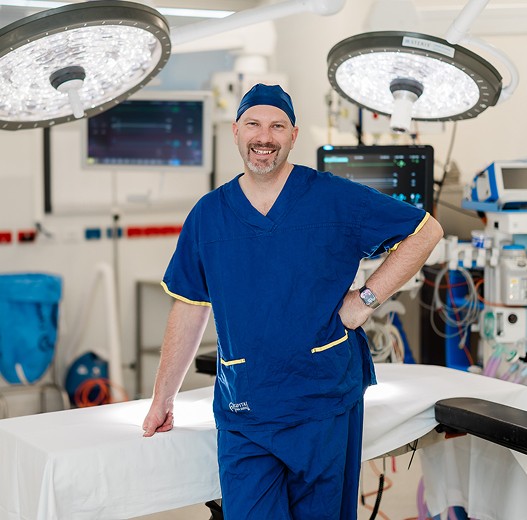DBS involves the implantation of a small neurostimulator (similar to a pacemaker), which delivers finely tuned electrical impulses to targeted regions of the brain. This modulates abnormal activity in the brain circuits responsible for tremor, reducing symptoms and restoring independence.
A/Prof Peter Mews has subspecialty expertise in functional neurosurgery, including DBS for movement disorders. By offering this advanced therapy across Canberra, Wagga Wagga and the South Coast, he ensures patients can access world-class neurosurgical care closer to home.
DBS is a neurosurgical procedure in which thin electrodes are placed into specific areas of the brain involved in movement control. These electrodes are connected to a battery-powered neurostimulator implanted under the skin of the chest. The system delivers continuous, adjustable electrical stimulation to regulate abnormal brain activity.
Unlike older surgical procedures which permanently destroy parts of the brain, DBS is reversible and adjustable. The settings can be customised for each patient and fine-tuned over time to achieve the best balance of tremor control with minimal side effects.
Benefits of DBS include:
In Australia, around 100,000 people live with Parkinson’s disease, and essential tremor is even more common, though often underdiagnosed. DBS provides an option for patients whose movement disorder cannot be adequately managed with medication alone.
Essential tremor is the most common movement disorder, often affecting the hands, head or voice. It is usually hereditary and worsens gradually over time. While medications such as propranolol or primidone may help, many patients eventually experience inadequate control.
Treatment options:
DBS has been shown to provide marked and durable improvement in tremor control, often restoring the ability to eat, drink or write without significant interference.
Parkinson’s disease is a progressive neurological disorder caused by the loss of dopamine-producing cells in the brain. Tremor is a hallmark symptom, alongside stiffness, slowness of movement and balance problems. While medications such as levodopa can be effective, tremor may persist or fluctuate despite optimal therapy.
Treatment options:
DBS for Parkinson’s disease can significantly reduce symptoms, improve quality of life and reduce medication requirements in selected patients.
Dystonia is a neurological condition causing abnormal muscle contractions and postures. In some patients. Medications often provide limited benefit, and surgical therapy may be considered.
Treatment options:
DBS can be effective in reducing dystonic symptoms, improving function in patients who otherwise have limited options.
DBS may also be considered in selected cases of:
These cases are less common but may benefit from individualised assessment and management

DBS is one of the most technically demanding procedures in neurosurgery, requiring detailed knowledge of brain circuitry, advanced surgical precision and careful patient selection.
A/Prof Peter Mews has significant expertise in functional neurosurgery, with DBS being one of his key subspecialty interests. His training and experience allow him to provide highly individualised care, from initial assessment through to surgery and ongoing programming of the stimulator.
By consulting across Canberra, Wagga Wagga and Moruya (South Coast), he makes advanced surgical treatment for tremor disorders accessible to patients who might otherwise need to travel interstate. For many, DBS can mean the difference between dependence and restored independence in daily life.